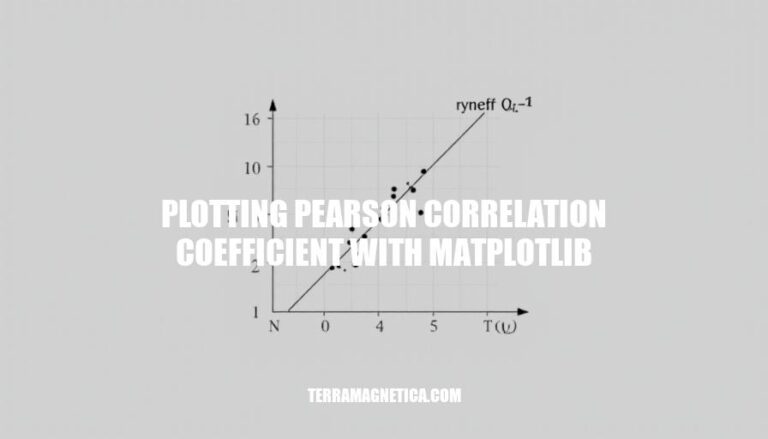


Plotting the Pearson correlation coefficient with Matplotlib is a key technique in data analysis and visualization. This coefficient measures the linear relationship between two variables, ranging from -1 to 1. Visualizing it helps identify patterns and correlations in data, making it easier to understand relationships and make informed decisions. Using Matplotlib, you can create clear and informative plots to effectively communicate these insights.
The Pearson correlation coefficient (denoted as ( r )) quantifies the strength and direction of the linear relationship between two continuous variables. It ranges from -1 to 1:
Significance in statistical analysis:
Calculation:
[ r = \frac{\sum (x_i – \bar{x})(y_i – \bar{y})}{\sqrt{\sum (x_i – \bar{x})^2 \sum (y_i – \bar{y})^2}} ]
Where ( x_i ) and ( y_i ) are the individual sample points, and ( \bar{x} ) and ( \bar{y} ) are the means of the ( x ) and ( y ) variables, respectively.
Here are the steps to set up a Python environment for plotting the Pearson correlation coefficient with Matplotlib:
Install Python:
Create a Virtual Environment:
python -m venv myenv
Activate the Virtual Environment:
myenv\Scripts\activate
source myenv/bin/activate
Install Necessary Libraries:
pip install numpy pandas matplotlib scipy
Write the Python Script:
import numpy as np
import pandas as pd
import matplotlib.pyplot as plt
from scipy.stats import pearsonr
# Sample data
data = {'x': [1, 2, 3, 4, 5], 'y': [2, 3, 4, 5, 6]}
df = pd.DataFrame(data)
# Calculate Pearson correlation coefficient
corr, _ = pearsonr(df['x'], df['y'])
print(f'Pearson correlation coefficient: {corr}')
# Plotting
plt.scatter(df['x'], df['y'])
plt.title(f'Pearson correlation coefficient: {corr:.2f}')
plt.xlabel('X')
plt.ylabel('Y')
plt.show()
Run the Script:
python script_name.py
This will set up your environment and plot the Pearson correlation coefficient using Matplotlib.
Here’s a step-by-step guide to calculate the Pearson correlation coefficient using Python:
import numpy as np
import pandas as pd
from scipy.stats import pearsonr
You can create a DataFrame or load your data from a file.
# Example data
data = {'variable1': [2, 4, 5, 8, 10], 'variable2': [1, 3, 5, 6, 9]}
df = pd.DataFrame(data)
correlation_matrix = df.corr()
print(correlation_matrix)
corr, _ = pearsonr(df['variable1'], df['variable2'])
print(f'Pearson correlation coefficient: {corr}')
corr_matrix = np.corrcoef(df['variable1'], df['variable2'])
print(corr_matrix)
That’s it! You can use any of these methods to calculate the Pearson correlation coefficient in Python.
Here’s how you can plot the Pearson correlation coefficient with Matplotlib, including creating scatter plots and adding correlation lines:
Import Libraries:
import numpy as np
import matplotlib.pyplot as plt
from scipy.stats import pearsonr
Generate Sample Data:
np.random.seed(0)
x = np.random.rand(100)
y = 2 * x + np.random.normal(0, 0.1, 100)
Calculate Pearson Correlation Coefficient:
corr, _ = pearsonr(x, y)
print(f'Pearson correlation coefficient: {corr}')
Create Scatter Plot:
plt.scatter(x, y, label=f'Pearson r = {corr:.2f}')
Add Correlation Line:
m, b = np.polyfit(x, y, 1)
plt.plot(x, m*x + b, color='red')
Customize and Show Plot:
plt.xlabel('X-axis')
plt.ylabel('Y-axis')
plt.title('Scatter Plot with Correlation Line')
plt.legend()
plt.show()
This will create a scatter plot of your data points and add a red correlation line, showing the relationship between the variables.
Here are various customization options in Matplotlib for enhancing Pearson correlation coefficient plots:
cmap to apply different color schemes, such as plt.cm.viridis or sns.diverging_palette.annot=True in Seaborn’s heatmap.mask=np.triu(np.ones_like(corr, dtype=bool)).cbar_kws to adjust its size and location.plt.title, plt.xlabel, and plt.ylabel.plt.figure(figsize=(width, height)).linestyle and marker parameters.plt.grid(True/False).These options help in creating more informative and visually appealing correlation plots.
To interpret plots for correlation:
Scatterplots: Look at the overall pattern of the points.
Correlation Coefficient ®:
Trend Line: A line of best fit can help visualize the direction and strength. A steeper slope indicates a stronger relationship.
By examining these aspects, you can understand both the strength and direction of the correlation in your data.
Start by importing necessary libraries such as numpy for numerical operations and matplotlib.pyplot for creating plots.
Then, calculate the correlation coefficient using the corrcoef function from numpy’s library.
Next, create a scatter plot of your data points with the correlation line added on top. Customize the plot by adding labels, titles, and legends to make it more informative.
Various options are available in Matplotlib for enhancing Pearson correlation coefficient plots, including color maps, annotations, masks, color bars, titles and labels, figure size, line styles and markers, and grid lines.
To interpret plots for correlation, examine the overall pattern of scatterplots, looking at direction and strength. The correlation coefficient (r) ranges from -1 to 1, with values closer to 1 indicating strong positive correlations, values close to -1 indicating strong negative correlations, and values around 0 indicating weak or no correlation.
A trend line can also be added to visualize the direction and strength of the relationship. By analyzing these aspects, you can understand both the strength and direction of the correlation in your data.